Potřebujeme váš souhlas k využití jednotlivých dat, aby se vám mimo jiné mohly ukazovat informace týkající se vašich zájmů. Souhlas udělíte kliknutím na tlačítko „OK“.
ASTM D6113-11
Standard Test Method for Using a Cone Calorimeter to Determine Fire-Test-Response Characteristics of Insulating Materials Contained in Electrical or Optical Fiber Cables
Automaticky přeložený název:
Standardní zkušební metoda pro použití kužel kalorimetru zjistit Fire-Test-Response Charakteristika Izolační materiály obsažené v elektrických a optických kabelů
NORMA vydána dne 1.4.2011
Informace o normě:
Označení normy: ASTM D6113-11
Poznámka: NEPLATNÁ
Datum vydání normy: 1.4.2011
Kód zboží: NS-33841
Počet stran: 20
Přibližná hmotnost: 60 g (0.13 liber)
Země: Americká technická norma
Kategorie: Technické normy ASTM
Kategorie - podobné normy:
Zápalnost a hořlavost materiálů a výrobků
Izolační materiály obecně
Optická vlákna a kabely
Anotace textu normy ASTM D6113-11 :
Keywords:
cable, cone calorimeter, electrical cable, electrical insulation, fire, fire-test response, heat release, heat release rate, optical fiber cable, oxygen consumption calorimetry, smoke obscuration, Cone calorimeter, Electrical fiber cable, Electrical insulating materials, Fire-test response, Heat release, Insulating materials, Optical fiber/cable/conduit, Smoke obscuration, ICS Number Code 13.220.40 (Ignitability and burning behaviour of materials and products)
Doplňující informace
| Significance and Use | ||||||||||||||||||||||||||||||||
|
This test method is used to determine the heat release rate and a number of other fire-test-response characteristics as a result of exposing insulating materials contained in electrical or optical cables to a prescribed heating flux in the cone calorimeter apparatus. Quantitative heat release measurements provide information that is potentially useful for design of electrical or optical cables, and product development. Heat release measurements provide useful information for product development by giving a quantitative measure of specific changes in fire performance caused by component and composite modifications. Heat release data from this test method will not be predictive of product behavior if the product will not spread flame over its surface under the fire exposure conditions of interest. The fire-test-response characteristics determined by this test method are affected by the thickness of the material used as test specimen, whether as a plaque or as coating on a wire or cable. The diameter of the wire or cable used will also affect the test results. A radiant exposure is used as an energy source for this test method. This type of source has been used for comparison with heat release rate and flame spread studies of insulating materials constructed into cables when burning in a vertical cable tray configuration (Test Methods D5424 and D5537) (2-9). No definitive relationships have been established. The value of heat release rate corresponding to the critical limit between propagating cable fires and non-propagating fires is not known. This test method does not determine the net heat of combustion. It has not been demonstrated that this test method is capable of predicting the response of electrical or optical fiber cables in a full scale fire. In particular, this test method does not address the self-extinguishing characteristics of the cables in a full scale fire. |
||||||||||||||||||||||||||||||||
| 1. Scope | ||||||||||||||||||||||||||||||||
|
1.1 This is a fire-test-response standard. 1.2 Several fire-test-response characteristics, including the time to sustained flaming, heat release rate, total heat released, effective heat of combustion, and specific extinction area; are measured or calculated by this test method at a constant radiant heating flux. For specific limitations see also 5.7 and Section 6. 1.3 The tests are conducted by burning the electrical insulating materials contained in electrical or optical fiber cables when the cable test specimens, excluding accessories, are subjected to radiant heat. 1.4 The values stated in SI units are to be regarded as the standard. The values given in parentheses are for information only. 1.5 This standard does not purport to address all of the safety concerns, if any, associated with its use. It is the responsibility of the user of this standard to establish appropriate safety and health practices and determine the applicability or regulatory limitations prior to use. For specific precautionary statements, see Section 7. 1.6 This standard measures and describes the response of materials, products, or assemblies to heat and flame under controlled conditions, but does not by itself incorporate all factors required for fire hazard or fire risk assessment of the materials, products or assemblies under actual fire conditions. 1.7 Fire testing is inherently hazardous. Adequate safeguards for personnel and property shall be employed in conducting these tests. |
||||||||||||||||||||||||||||||||
| 2. Referenced Documents | ||||||||||||||||||||||||||||||||
|
Podobné normy:
Historická
1.1.2010
Historická
1.5.2014
Historická
1.6.2010
Historická
1.3.2010
Historická
1.11.2013
Historická
1.3.2010
Doporučujeme:
Aktualizace technických norem
Chcete mít jistotu, že používáte pouze platné technické normy?
Nabízíme Vám řešení, které Vám zajistí měsíční přehled o aktuálnosti norem, které používáte.
Chcete vědět více informací? Podívejte se na tuto stránku.



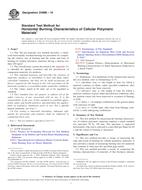 ASTM D4986-10
ASTM D4986-10 ASTM D5048-14
ASTM D5048-14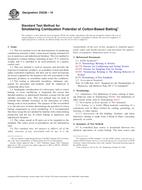 ASTM D5238-10
ASTM D5238-10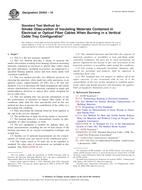 ASTM D5424-10
ASTM D5424-10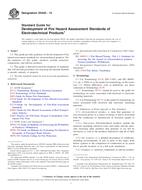 ASTM D5425-13
ASTM D5425-13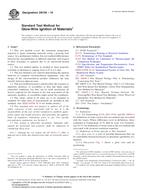 ASTM D6194-10
ASTM D6194-10
 Cookies
Cookies
